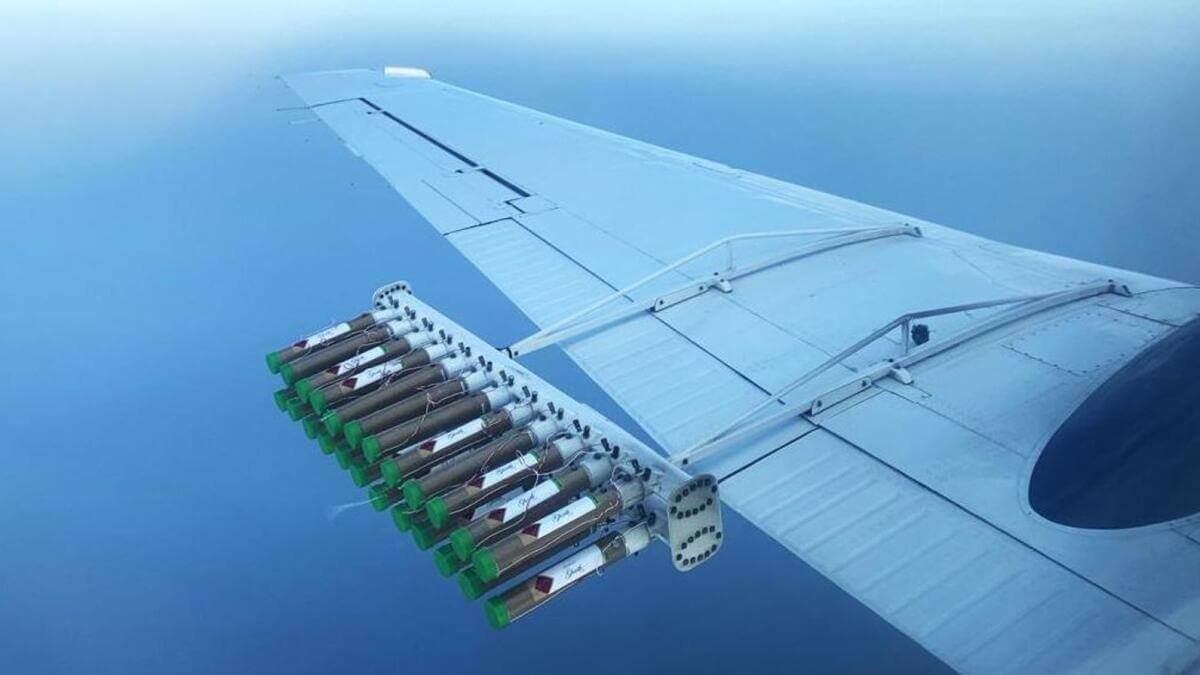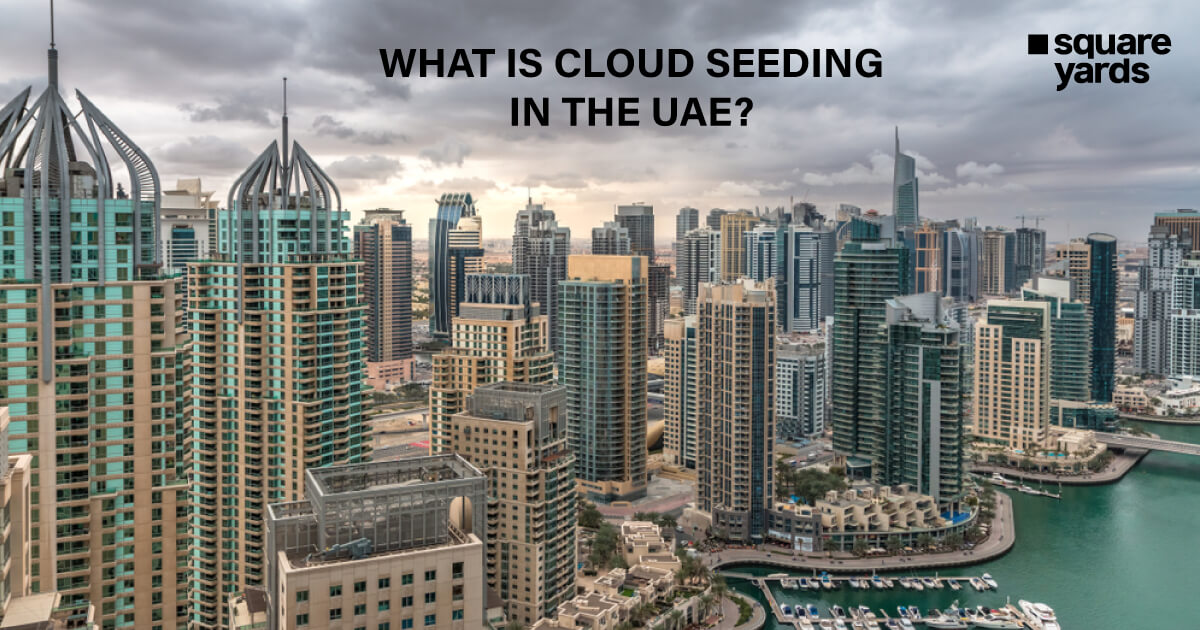The United Arab Emirates (UAE) is known for its scorching heat and arid climate, where water scarcity is a persistent issue. To tackle this, the UAE has invested in innovative solutions, including cloud seeding, a process of artificially inducing rain. In recent years, cloud seeding in UAE has gained significant attention and is used to increase rainfall in the country’s drought-prone regions. While some view it as a promising solution to alleviate water scarcity, others are sceptical about its effectiveness and environmental impacts.
This article will delve into the world of cloud seeding and its use in the UAE, exploring its science, history, techniques, and effects surrounding it.
What is Cloud Seeding?

Cloud seeding is a weather modification technique that involves introducing certain substances into the clouds to enhance precipitation. The substances used in cloud seeding can be either natural or synthetic, and they work by stimulating the cloud to produce more rain or snowfall than it would otherwise. Cloud seeding is often used in areas where rainfall is scarce or during droughts to increase the amount of precipitation that falls.
There are several methods of cloud seeding, including dropping chemicals from aeroplanes, firing rockets into the clouds, and using ground-based generators. The practice of cloud seeding has been around since the early 1940s and has evolved over the years.
-
Climate Prerequisites
The United Arab Emirates (UAE) has a hot and arid climate with very low annual rainfall, which makes it an ideal location for cloud seeding. However, cloud seeding requires specific climate conditions to be effective.
Cloud seeding in UAE is most effective during winter months (Nov-Feb) with cooler weather and higher humidity. Thick cloud cover increases the chances of precipitation. Stable atmospheric conditions with light winds are also necessary for effective cloud seeding as strong winds can disperse the cloud-seeding substances.
-
Evolution of Cloud Seeding
In 1946, a researcher named Vincent Schaefer discovered he could stimulate precipitation by dropping dry ice (frozen carbon dioxide) into a cloud. In the UAE, cloud seeding was first introduced in the 1990s to solve the country’s water scarcity problems. Today, the NCM uses advanced methods to monitor weather patterns and deploy cloud seeding technology to maximise regional rainfall. The success of cloud seeding in the UAE has made it a leading player in weather modification and has inspired other countries to explore this technology as well.
-
Cloud Seeding in the UAE

Cloud seeding in the UAE involves introducing salt crystals into clouds to encourage rainfall. The salt crystals act as a nucleus for the formation of rain droplets. The most common material for cloud seeding is sodium chloride, commonly found in seawater. The salt crystals are released into the clouds either directly from the air or using ground technology.
The Process Behind Artificial Rain in the UAE
Artificial rain in the UAE is made through the process of cloud seeding. This involves introducing substances, such as salt crystals or dry ice, into the clouds to encourage the formation of raindrops. Cloud seeding can be done using various methods, including aircraft, mobile towers, and ground-based generators. The technology’s effectiveness depends on several factors, such as weather conditions and the location of the clouds.
-
Cloud Seeding Using Aircraft

Cloud seeding in the UAE can be done using aeroplanes or drones. These aircrafts are equipped with flares that contain salt crystals. The flares are ignited and released into the clouds, which act as a nucleus for the formation of rain droplets. The aeroplanes can cover a larger area, making cloud seeding more effective.
-
Cloud Seeding Through Land Technology
Cloud seeding can also be done from the ground. In the UAE, cloud seeding is done using mobile towers that release salt crystals into the clouds. The towers can be moved to different locations to cover a larger area. These are also cheaper to operate than aircrafts.
-
Cloud Seeding Using Nano-Technology
The UAE is also exploring new technologies to enhance cloud seeding. One such technology is using nano-materials. The technology involves using nanoparticles to create rain. The nanoparticles are released into the clouds, where they act as a nucleus for the formation of rain droplets.
Impact of Cloud Seeding
Cloud seeding has been an innovative solution for the United Arab Emirates in addressing water scarcity issues. By introducing certain elements to the clouds, cloud seeding artificially enhances precipitation, which has led to an increase in water resources for domestic and industrial use as well as agriculture. Furthermore, cloud seeding has also significantly affected the region’s climate and environment.
-
Advantages of Artificial Rain/Cloud Seeding

The benefits of cloud seeding in the UAE are numerous. Artificial rain can increase water availability for agriculture, livestock, and human consumption. It can also reduce the occurrence of dust storms and air pollution, which is common in the region. Cloud seeding can also reduce the occurrence of hail, which can damage crops and property.
-
Disadvantages of Artificial Rain/Cloud Seeding
There are also certain negative effects of cloud seeding in the UAE. The salt crystals used in cloud seeding can accumulate in the soil and water bodies, leading to increased salinity. This can affect the growth of crops and vegetation and can also harm aquatic life. The long-term effects of cloud seeding on the environment are still being studied, and more research is needed to understand the potential risks.
Cost of Cloud Seeding In UAE
The cost of cloud seeding in the UAE varies depending on the method used, the location, and the amount of rainfall desired. The expense associated with utilising aircrafts for cloud seeding in UAE is more expensive than using mobile towers. For a cost of approximately $5,000, up to 24 clouds can be seeded during an average four-hour operation.
The Role of the Government in Cloud Seeding Efforts
The UAE government is heavily involved in cloud seeding. The government of the UAE has invested 18 million dollars in cloud-seeding technology to enhance rainfall in the region. The government is also exploring new technologies, such as nano-materials, to make cloud seeding more effective.
Wrapping Up
Cloud seeding in UAE has been used to increase rainfall in the country’s drought-prone regions since the 1990s. The process involves introducing certain chemicals, such as salt crystals, into clouds to encourage the formation of rain droplets. While cloud seeding has positively impacted water availability, air pollution reduction, and crop damage prevention, there are concerns about its long-term environmental impact and increased salinity in soil and water bodies. Cloud seeding is costly, and its effectiveness depends on various factors such as weather conditions, the location of the clouds, and the method used. The government is also involved in further cloud seeding, which is considered a promising solution to the country’s water scarcity issues.
Some Useful Articles for you :
|
Guide To Dubai Electricity And Water Authority |
|
|
Reason of High Consumption of Electricity And Water |
|
|
Advantage of Online SEWA |
Frequently Asked Question (FAQs)
Cloud seeding is the process of artificially stimulating precipitation in clouds to enhance rainfall. Cloud seeding in UAE uses various methods, such as aircraft, mobile towers, and ground-based generators. The cloud-seeding material is sprayed into the clouds, which stimulates the formation of raindrops and enhances rainfall.
Cloud seeding in UAE has several impacts, including increased rainfall, reduced dust storms and air pollution, and protection of crops from hail damage. However, the potential negative effects of cloud seeding on the environment are still being studied, and more research is needed to understand the potential risks.
Seeding as many as 24 clouds is feasible during an average four-hour operation, which may cost around $5,000 using aircrafts.
Cloud seeding is used in several countries worldwide, including the United States, China, Australia, and the UAE.
Cloud seeding is important because it can help alleviate water scarcity in regions with low rainfall. It can also reduce the occurrence of dust storms and air pollution and protect crops from hail damage.
The advantages of cloud seeding include increased rainfall, reduced dust storms and air pollution, and protection of crops from hail damage. However, the potential negative effects of cloud seeding on the environment are still being studied, and more research is needed to understand the potential risks. Additionally, cloud seeding can be costly, and the effectiveness of the technology is dependent on several factors, such as weather conditions and the location of the clouds. What is cloud seeding? How is it done in the UAE?
What is the impact of cloud seeding in the UAE?
How much does it cost to seed clouds in the UAE?
Which country uses cloud seeding?
What is the importance of cloud seeding?
What are the advantages and disadvantages of cloud seeding?




